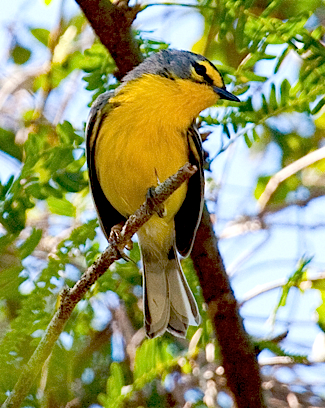For our tour description, itinerary, past triplists, dates, fees, and more, please VISIT OUR TOUR PAGE.
See this triplist in printable PDF format with media only on page 1.

With an engaging
personality to go along with its good looks, it's no wonder
the dapper little Puerto Rican Tody was a favorite for many.
The todies are one of only two families endemic to the
Caribbean islands, the other being the Palmchat of
Hispaniola. (Photo by guide George Armistead)
Our 2012 sojourn into the commonwealth of Puerto Rico, the smallest island in the Greater Antilles, proved fruitful and relaxing, and yielded many memorable birds.
An early morning getaway the first day got us out of town and into the Haystack Hills. We were floored to step out of our vans and immediately hear a pair of Puerto Rican Screech-Owls dueting. Soon, we had them in the telescopes for leisurely studies, and we watched them drift off to sleep just as the other forest birds came alive. Zenaida Doves, Puerto Rican Bullfinches, and Antillean Euphonias were calling, and then we discovered a lovely pair of Lesser Antillean (Puerto Rican) Pewees picking bugs amid the sun-dappled mid-story canopy of this humid patch of forest. No parrots were to be seen or heard (at least with any certainty), but sightings of about nine endemics had us off to a roaring start. We lunched at some cliffs where White-tailed Tropicbirds sailed around in display, with males courting females, against cerulean skies. Then came the rains. Afternoon showers were to be a daily occurrence on the tour, but thankfully the birding gods mostly smiled upon us allowing us good weather nearly every morning and at other critical points. Our second morning we visited the incomparable Laguna Cartagena, where we hit upon the trifecta of Caribbean waterfowl in a big way. White-cheeked Pintails were in evidence while West Indian Whistling-Ducks and Masked Ducks were counted in dozens! Amazing! Also there were Purple Gallinules, Soras, and a nice array of ducks and herons.
An afternoon downpour spoiled our best shot at Key West Quail-Dove, though fleeting sights of three birds at least indicated we were in the right area. Best of all was after a picnic dinner, when in one of our luckier moments on the trip, a Puerto Rican Nightjar began calling nearby, and soon we were enjoying prolonged views of one of the world's rarest nightjars. We spent the following morning in the Maricao highlands where we quickly tallied the islands most unique species, the Puerto Rican Tanager. That was followed up by brilliant sightings of the island's rarest bird aside from the parrot, the Puerto Rican Sharp-shinned Hawk. A handsome male sat up and preened for us at some length, and he provided us our 2nd most popular bird of the trip. It took some work to get our first good sighting of an Elfin-woods Warbler, but after that we seemed to stumble across them effortlessly. We enjoyed several simply magical sightings of this island icon.
A final morning in the dry forest was undertaken before heading east. We heard several more Key West Quail-Doves but never glimpsed a feather on them, but did enjoy multiple good views of the trip's favorite bird, the tody. Todies simply must be seen to be believed. There are no words that do justice to their charms. After some sweet sightings of them and some of the odd and squirrelly lizard-cuckoo we headed east to El Yunque. Our lodging for the final two nights is tough to beat. With a wonderful waterfall view, and lush forest all around, the Scaly-naped Pigeons dodging this way and that, the Puerto Rican Orioles industriously working away at their nest, and the Loggerhead Kingbirds sputtering and stuttering in between bouts of harrassing orioles, there was plenty to look at. Our final day afield, we headed down into the lowlands and easily tallied our final two targets in some snazzy hummingbirds. Green-throated Caribs were most accommodating, and the dapper little Antillean Crested Hummingbird put in several appearances as well.
It was a pretty good haul, all in all. Eric and I want to thank everyone for making the trip such a success. The birds were great, and we enjoyed some good food, but birding with people of such good cheer really made it a great experience. Thanks again, and we hope to see you out birding again soon.
--George
For more information about this tour, including future departures, visit our website at www.fieldguides.com. And to see this same triplist online, go to http://www.fieldguides.com/triplists/ptr12LIST.pdf and you will find the list in its entirety.
KEYS FOR THIS LIST
One of the following keys may be shown in brackets for
individual species as appropriate: * = heard only, I =
introduced, E = endemic, N = nesting, a = austral migrant, b =
boreal migrant
BIRDS

Mangrove Cuckoos
are widespread and common throughout the Caribbean
islands, and, contrary to their name, occur in a variety
of habitats, not just mangroves. (Photo by guide George
Armistead)

With only about
1200 birds remaining, the Yellow-shouldered Blackbird is
one of PR's rarest endemics. Fortunately, they are still
relatively numerous and easy to find in their stronghold
in the southwest of the island. (Photo by guide George
Armistead)

A denizen of
highland forests, the striking little Elfin-woods Warbler
was the last Puerto Rican endemic to be discovered, as
late as 1968! (Photo by guide George Armistead)

The other endemic
warbler of Puerto Rico, the Adelaide's Warbler, was once
lumped with both St. Lucia Warbler and Barbuda Warbler;
all three are considered good species now. (Photo by guide
George Armistead)

A surprising 8
species of woodpeckers are endemic to the Caribbean
islands; all but one of them are single island endemics,
like the handsome male Puerto Rican Woodpecker shown here.
(Photo by guide George Armistead)
ADDITIONAL COMMENTS
Totals for the tour: 110 bird taxa and 0 mammal taxa
